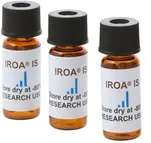- Internal Standard for use with the TruQuant Workflow Kit
- No false data. Identifies only compounds of biological origin; excludes artifactual peaks.
- Accurate compound formula ID for MS alone; complete ID with addition of SWATH, or IM.
- Fragments have the IROA ratio pattern derived from their parent peaks and can be identified using the “peak correlation” ClusterFinder module.
- Suppression-corrected measurements for significantly better quantitation.
- Sample normalization to a universal standard for complete comparability.
- ClusterFinder software solution builds libraries, IDs/quantitates compounds, corrects for ion-suppression and normalizes data.
- Mass-spec vendor agnostic.
 Economical. $100 for 90 samples.
Economical. $100 for 90 samples.
Summary of Benefits of the TruQuant Internal Standard (IS)
Kit Contents
Materials and tools for the analysis of 90 experimental samples; for use with the TruQuant Workflow
- IROA Internal Standard (IROA-IS): 3 vials of lyophilized unique 95% U-13C fully-labeled S. cerevisiae Yeast Extract*
- ClusterFinder™ software, including the library of IROA peaks and their physical characteristics identified in the Long-Term Reference Standard (LTRS)**
- User Manual
Storage: -80ºC, protected from light
*Prepared from proprietary U-95% 13C IROA-labeled glucose specially produced for IROA Technologies by Cambridge Isotope Laboratories, Inc. (CIL).
The IROA Internal Standard (IROA-IS)
The IROA-IS is created to be uniformly labeled at approximately 5% for the 12C isotope, and approximately 95% for the second isotope, 13C. The 95% U-13C labeled peaks are mathematically calculable and readily identified by the IROA ClusterFinder software. The IROA-IS together with ClusterFinder software are used to co-locate, identify, and quantitate 400 to 600[1] biochemicals in experimental samples, depending upon chromatographic mode(s) employed.
The IROA-IS can be spiked into any natural abundance experimental sample (cells, tissue biopsy, plant material, blood, etc.) to identify and quantitate metabolites using the LTRS “dictionary”. (The IROA-LTRS, provided in the Workflow Kit, is used to build a triply redundant dictionary/library of RT, m/z and physical characteristics including fragmentation data. All peaks are named according to the IROA-LTRS database. The adducts and fragments for each compound are indexed individually. These compound IDs are loaded into ClusterFinder’s internal databases as a separate editable IROA-LTRS database.)
[1] As of ClusterFinder version 4.2.26 the IM CCS handling is not yet fully functional. Many peaks are fragments or adducts of a parent compound.
Functions of the IROA Internal Standard
- The IROA-IS is used to find and align all the peaks.
- The alignment of all samples ensures reduced variability in day-to-day measurements.
- The characteristics for each compound in the IROA-IS allow the calculation of a suppression-corrected area for each compound. Suppression correction and normalization are implemented in ClusterFinder using the qualities inherent in the IS peaks. The user is always presented with raw, suppression corrected, and normalized data so the best choice may always be available according to any experimental design.
- The normalization of the total area under the curve (AUC) for all natural abundance suppression-corrected peaks to the total AUC of their corresponding IROA-IS peaks is a “Dual MSTUS[1]” algorithm that allows for normalization of samples not only within a single day’s run, but since the IROA-IS is equivalent every day; all normalizations are to a true Standard, i.e. that is the same every day. Normalization overcomes sample-to-sample variation.
- The IROA-IS can be used to build a Retention Index to track “unknown” compounds not identified in the IROA-IS.
[1] MSTUS described in “Normalization strategies for metabonomic analysis of urine samples” Warrack et al.
